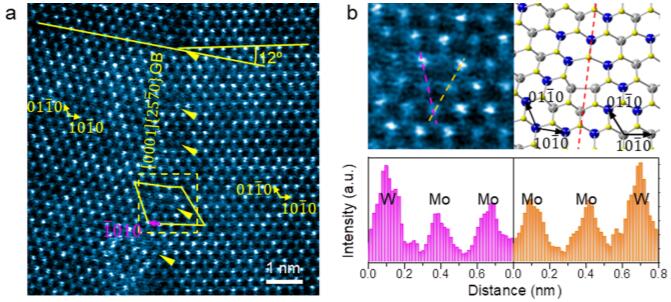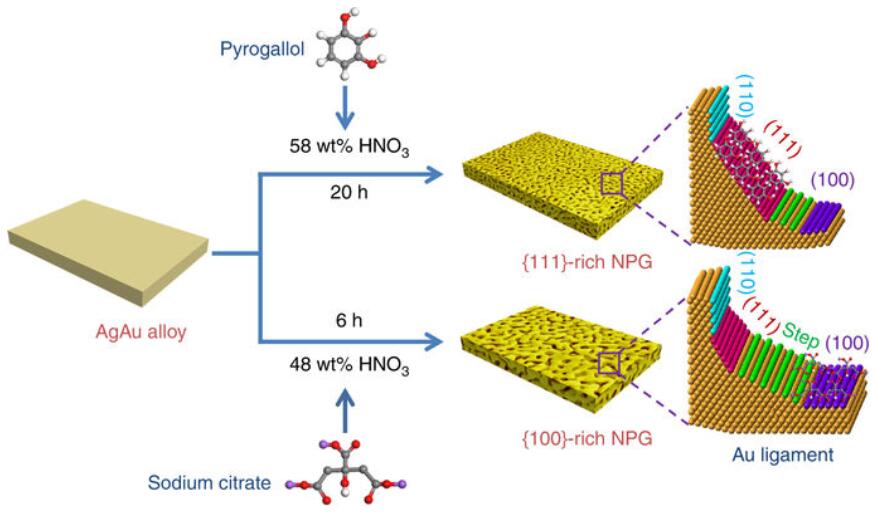2D Materials
Metallic Glasses
Nanoporous Metals
Nanoporous Graphene
Structural Characterization of 2-Dimensional Materials
2D transition metal dichalcogenides TMDs are attractive for their unconventional physical and chemical properties, which are strongly related to their structures in atomic scale. In Chen group, we explore the unique properties of 2D TMDs
and their derivatives by studying the special structures in atomic scale.
Chemical Selectivity at Grain Boundary Dislocations in Monolayer Mo1–xWxS2 Transition Metal Dichalcogenides


Grain boundaries are unavoidable crystal defects in polycrystalline materials and significantly influence their properties. However, the structure and chemistry of GBs in 2D transition metal dichalcogenide alloys have not been well established.
Here we report significant chemical selectivity of transition metal atoms at GB dislocation cores in Mo1–xWxS2 monolayers. Different from classical elastic field-driven dislocation segregation in bulk crystals,
the chemical selectivity in the 2D crystals originates prominently from variation of atomic coordination numbers at dislocation cores. This observation provides atomic insights into the topological effect on the chemistry of crystal
defects in 2D materials.
Wang, Ziqian, et al. ACS applied materials & interfaces 2017
Synthesizing 1T–1H Two-Phase Mo1–xWxS2 Monolayers by Chemical Vapor Deposition

1T−1H metal−semiconductor interfaces in two-dimensional transition-metal dichalcogenides play a crucial role in utilizing the band gaps of TMDs for applications in electronic devices. Although the 1T−1H two-phase structure has been
observed in exfoliated 2D nanosheets and chemically or physically treated TMDs, it cannot in principle be achieved n large-scale TMD monolayers grown by chemical vapor deposition, which is a abrication method for electronic
device applications, because of the metastable nature of the 1T phase. In this study we report CVD growth of 1T−1H two phase TMD monolayers by controlling thermal strains and alloy compositions. It was found that in-plane thermal
strains arising from the difference in thermal expansion coefficients between TMD monolayers and substrates can drive the 1H to 1T transition during cooling after CVD growth. Moreover, grain boundaries in the 2D crystals act as
the nucleation sites of the 1T phase and the lattice strain perturbations from alloying noticeably promote the formation of the metastable 1T phase. This work has an important implication in tailoring structure and properties of
CVD grown 2D TMDs by phase engineering.
Wang, Ziqian, et al. ACS nano 2018
Atomic Structure and Dynamic Behavior of Bulk Metallic Glass
The most notable property of bulk metallic glasses (BMGs) is their ultrahigh strength and hardness that cannot be achieved in their crystalline counterparts. Nevertheless, BMGs generally suffer from low ductility at room temperature because
shear bands, the sole carriers of plastic deformation, initiate strain softening and result in failure of BMGs with limited plasticity. It has been widely recognized that mechanical properties of BMGs virtually depends on the nucleation
and propagation of shear bands. However, the underlying mechanism on the shear localization remains unclear. With the support of this project, we have extensively investigated the micromechanisms of mechanical behavior of BMGS from
atomic and sub-nanometer scales.
Correlation between Local Structure Order and Spatial Heterogeneity in a Metallic Glass

Although nanoscale spatial heterogeneity of metallic glasses has been demonstrated by extensive experimental and theoretical investigations, the nature of spatial heterogeneity remains poorly known owing to the absence of a structural
depiction of the inhomogeneity from experimental insight. Our group reported the experimental characterization of the spatial heterogeneity of a metallic glass by utilizing state-of-the-art angstrom-beam electron diffraction and scanning
transmission electron microscopy. The subnanoscale electron diffraction reveals that the nanoscale spatial heterogeneity and corresponding density fluctuation have a close correlation with the local structure variation from icosahedronlike
to tetragonal crystal-like order. The structural insights of spatial heterogeneity have important implications in understanding the properties and dynamics of metallic glasses.
F. Zhu et al., Phys. Rev. Lett., 2017.
Geometric Frustration of Icosahedron in Metallic Glasses

The structure of glassy materials, which are known to have short-range order but no long-range pattern, continues to be a puzzle. One theory is that some glassy materials possess icosahedral ordering, a motif that cannot show translational
periodicity. Our group obtained diffraction patterns from subnanometer volumes in a metallic glass, which show some, but not all, of the expected features of an icosahedron. Simulations suggest that the patterns arise from icosahedrons
distorted to include features of the face-centered cubic structure. This observation is different from the predictions of molecular dynamics simulations and provides pivotal information in understanding the competition between the
formation of the globally inexpensive long-range order and the locally inexpensive short-range order.
A. Hirata, et. al., Science (2013)
Development and characterization of nanoporous materials
The overall motivation of this research is to extend our success in synthesis of nanoporous noble metals and composites along with development of a new fabrication technique of nanoporous non-noble transition metals by using chemical and
electrochemical approaches. The produced nanoporous metals will possess three-dimensional bicontinuous structure with a tunable pore size from a few nanometers to hundreds of nanometers. This new type of nanoporous materials holds
unique promises for applications in bio-MEMS, nano-devices, and nano-mass transportation systems.
Engineering the internal surfaces of three-dimensional nanoporous catalysts by surfactant-modified dealloying

Z. Wang et al., Adv. Mater., 2017.
Tuning surface structures by bottom-up synthesis has been demonstrated as an effective strategy to improve the catalytic performances of nanoparticle catalysts. Nevertheless, the surface modification of three-dimensional nanoporous metals,
fabricated by a top-down dealloying approach, has not been achieved despite great efforts devoted to improving the catalytic performance of three-dimensional nanoporous catalysts. Our group report a surfactant-modified dealloying method
to tailor the surface structure of nanoporous gold for amplified electrocatalysis toward methanol oxidation and oxygen reduction reactions. With the assistance of surfactants, faceted internal surfaces of nanoporous gold can be realized
in a controllable manner by optimizing dealloying conditions. The surface modified nanoporous gold exhibits significantly enhanced electrocatalytic activities in comparison with conventional nanoporous gold. This study paves the way
to develop high-performance three-dimensional nanoporous catalysts with a tunable surface structure by top-down dealloying for efficient chemical and electrochemical reactions.
Three-dimensional bicontinuous nanoporous materials by vapor phase dealloying

Three-dimensional bicontinuous open nanoporosity has been recognized as an important nanoarchitecture for catalysis, sensing, and energy storage. Dealloying, i.e., selectively removing a component from an alloy, is an efficient way to
fabricate nanoporous materials. However, current electrochemical and liquid-metal dealloying methods can only be applied to a limited number of alloys and usually require an etching process with chemical waste. Here, we report
a green and universal approach, vapor-phase dealloying, to fabricate nanoporous materials by utilizing the vapor pressure difference between constituent elements in an alloy to selectively remove a component with a high partial vapor
pressure for 3DBO nanoporosity. We demonstrate that extensive elements, regardless of chemical activity, can be fabricated as nanoporous materials with tunable pore sizes. Importantly, the evaporated components can be fully recovered.
This environmentally friendly dealloying method paves a way to fabricate 3DBO nanoporous materials for a wide range of structural and functional applications.
Lu, Zhen, et al. Nature communication 2018
Functional applications of 3D nanoporous graphene
We have successfully developed a nanoporous metal-based CVD technique for the growth of high-quality 3D nanoporous graphene with tunable pore sizes as well as coherent quantum electronic properties in the interconnected 3D structure. The
novel properties of large specific surface areas, high porosity, high electron mobility and efficient mass transport render the nanoporous graphene a sought-after material for applications in transistors, electrocatalysis and electrochemical
energy storage.
Correlation between Chemical Dopants and Topological Defects in Catalytically Active Nanoporous Graphene

We systematically investigated the interaction between chemical dopants and topological defects in curved np-gra-phene and successfully synthesized nitrogen, sulfur, and phos-phorus co-doped 3D np-graphene with a high doping content by
tuning pore sizes of np-graphene. The highly curved gra-phene with a high density of geometrically required topological defects can accommodate more chemical dopants as either electron acceptors or donors. Besides stabilizing and hosting
dopants, the interplay between the chemical dopants and top-ological defects can effectively tune the local electronic struc-tures and lead to the H* adsorption Gibbs free energy close to that of commercial Pt catalysts. Such synergistic
effects result in a high density of highly active sites and thus superb cata-lytic performances of the chemically doped np-graphene with a larger curvature gradient toward high-efficiency electrochem-ical hydrogen production.
Ito, Yoshikazu, et al. Advanced Materials 2016